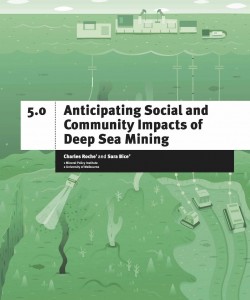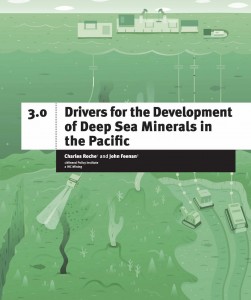These two articles are from an EU sponsored publication developed by GRID-Arendal for UNEP and the Secretariat of the Pacific Community. There was and continues to be some controversy as to the degree it was assisting Pacific Countries respond to deep-sea mining or actively promoting it.
Baker E. & Beaudoin Y. (eds.) (2013) Vol 1A, B, C, 2 Available here http://www.grida.no/publications/184 https://dsm.gsd.spc.int/index.php/publications-and-reports
Anticipating Social and Community Impacts of Deep Sea Mining

Authors: Roche, C and Bice, S Intro: Other chapters in this volume demonstrate that the mineral extraction potential of deep sea min- ing could be enormous, that economic opportunities are driving Pacific Island states’ exploration of deep sea mining, and that deep sea mining – if approached from a holistic environmental perspective – might offer Pacific Island states economic means of achieving development goals. But what of the social and community impacts of deep sea mining? How might communities be affected or societies changed when the most socially disruptive aspects of mining shift offshore? How can such impacts be predicted, measured, and monitored? And will communities be able to register complaints successfully, exercise decision-making authority, or grant a social licence to operate to an industry operating not in their backyards, but in their equally prized and culturally important seas?
Current knowledge suggests that
Drivers for the Development of Deep Sea Minerals in the Pacific

Authors: Roche, C & and Feenan, J
Intro: Could the world’s hunger for metals and minerals, and state strategies for securing access to them, propel the development of
Long-term decreasing metal industry productivity, falling ore grades, and increased costs, combined with increased environmental, social, and cultural expectations for sustainability, create an opportunity for
The focus of this chapter is the primary drivers of